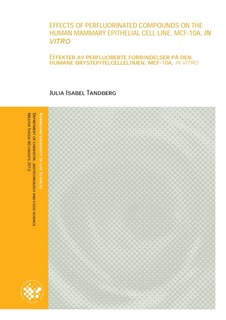Effects of Perfluorinated Compounds on the Human Mammary Epithelial Cell Line, MCF-10A, In vitro
Master thesis
Permanent lenke
http://hdl.handle.net/11250/186482Utgivelsesdato
2013-08-07Metadata
Vis full innførselSamlinger
- Master's theses (KBM) [890]
Sammendrag
There is a growing interest in assessing human health effects of persistent organic pollutants
(POPs), and several studies have reported in vitro or in vivo effects related to cancer. The
main aim of this study was to assess the potential effect of perfluorinated compounds (PFCs)
on breast cancer development in vitro, using the MCF-10A human mammary epithelial cell
line. Both MCF-10A monolayer and three-dimensional cultures were used to study the effect
of PFCs in a time-dose-dependent manner. Flow cytometry was used to assess the cell cycle
distribution of monolayer cultures. The percentage of cells in Sub-G0/G1, G0/G1, S and G2/M
were analyzed after 24, 48 and 72 hours in cells treated with 0, 100, 200, 300, 400 and 500
µM perfluorooctanesulfonic acid (PFOS), perfluorooctanoic acid (PFOA), perfluorononanoic
acid (PFNA), perfluorodecanoic acid (PFDA) and perfluoroundecanoic acid (PFUnA). In this
study only high concentrations of PFOS, PFNA and PFDA affected the cells, demonstrated by
an increased percentage of cells in Sub-G0/G1.
To further investigate the effect of PFCs, laser scanning confocal microscopy was used to
study acini polarization and lumen formation in MCF-10A three-dimensional cultures, treated
with 0, 0.6, 6 and 60 µM of the same PFCs as the monolayer cultures. Alterations in
polarization were determined at day 8 and 12, and lumen formation at day 3, 5, 7 and 10.
MCF-10A cells organize into three-dimensional cultures, generating acini, when grown on a
laminin-rich extracellular matrix. Acini formation begins with the clearance of the inner cells
by apoptosis, to form lumen, followed by polarization of the outer cells. The in vitro
observations showed that acini associated cell polarization and lumen clearance were
compromised in three-dimensional cultures exposed to PFOS, PFNA, PFDA and PFUnA,
even at the lowest exposure doses. In addition effects on lumen formation were observed due
to PFOA exposure. Overall, this study demonstrated a difference in sensitivity between
MCF-10A monolayer and three-dimensional cultures, and suggested a potential effect of
PFCs on breast cancer development. Persistente organiske miljøgifter og deres effekt på human helse har de siste årene fått økt
oppmerksomhet, og en rekke studier har rapportert in vitro eller in vivo eksponerings effekter,
inkludert kreftutvikling. Hovedformålet ved denne studien var å evaluere den potensielle
effekten av perfluorerte forbindelser (PFCs) med hensyn på brystkreft in vitro, ved bruk av
MCF-10A humane brystepitelceller. Både MCF-10A monolag og tredimensjonale kulturer ble
benyttet for å studere effekten av PFCs i en tid-dose-avhengig tilnærming. Flow cytometry ble
benyttet for å evaluere cellesyklusdistribueringen i monolagkulturer. Andelen celler i SubG0/G1, G0/G1, S og G2/M ble analyserte etter henholdsvis 24, 48 og 72 timer av celler
behandlet med 0, 100, 200, 300, 400 and 500 µM perfluoroktankarboksylsyre sulfonsyre
(PFOS), perfluoroktylsyre (PFOA), perfluoronononansyre (PFNA), og perfluorodekansyre
(PFDA) og Perfluoroundekansyre (PFUnA). Av de fem stoffene testet, påvirket PFOS, PFNA
og PFDA cellene, ved å øke antall celler i Sub-G0/G1.
For ytterligere å undersøke effekten av PFCs, ble det benyttet laser skanning konfokal
mikroskopi for å studere polarisering og lumen dannelse i MCF-10A acini strukturer. De
tredimensjonale kulturene ble behandlet med 0, 0,6, 6 og 60 µM av de samme stoffene brukt
på monolagkulturer. Endringer i acini polarisering ble analysert ved dag 8 og 12, og lumen
dannelse ved dag 3, 5, 7 og 10. MCF-10A celler danner tredimensjonale strukturer ved
kontakt med laminin-rik ekstracellulær matrix, som gir opphav til acini strukturer. Acini
dannelsen initieres ved apoptose av det indre laget med celler for dannelse av lumen,
etterfulgt av polarisering av det ytre cellelaget. In vitro observasjonene indikerte komprimert
polarisering og lumen dannelse i acini eksponert for PFOS, PFNA, PFDA og PFUnA, selv
ved lave eksponerings konsentrasjoner. I tillegg ble det observert endringer i lumen dannelse
ved PFOA eksponering. Resultatene presentert i denne studien viser med dette en forskjell i
sensitivitet mellom MCF-10A monolag og tredimensjonale kulturer, samt en potensiell link
mellom PFCs eksponering og økt risiko for brystkreft.
